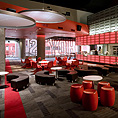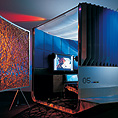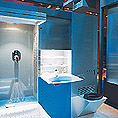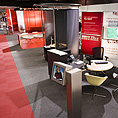|  | | | THE BANK OF THE FUTUREcontinuedMedia Bollard/Kiosk
The media bollard/kiosk is a single user electronic touch-screen information point. The content links the reality of the local branch service offer and spatial experience of the bank with the broader nationwide NAB media presence. The content and the range of digital display material are animated and filmic and convey a sense of life, change and interest that is greater than purely static messages. The storefront and the media bollards engage passers-by in an intimate way rather than addressing them as though they were in a football stadium. The bollards are ideally placed in small groups. There is one outside the glazing line available on a 24-hour basis and further bollards inside. Customers can use these while they are waiting or when ever they wish. |

|
Exhibition Wall
This zone is central to communicating the potential relationships the bank can have with its customers and exploring the theme of life's potentials and possibilities. The wall sized graphic posters present a contemporary magazine style landscape of information. The custom display system allows the poster elements to be easily changed. The impact of this collecting of all large format graphic display information is to build a very dynamic zone within the bank that also becomes part of the shop window when seen from the exterior. |
Web Kiosk
The web kiosk is a semi private research space for the bank's customers. This facility with web browser, printer and keyboard allows the customer to access bank and finance websites and to print out information. The space is a soft space with an intimate domestic scale. The web kiosk can seat three people on small upholstered banquettes. |

|
03.] Fast service blade wall ['Keep']
This element is to be a unique identifying feature of the NAB's new retail planning. It is an emblem of modern banking space. This wall is the high security zone of the bank and is emblematic of the position of trust that banking traditionally holds. It starts as the front facade of the bank with the street facing ATMs. Where possible it even projects out beyond the front of the bank or is readily visible as the front facade. It contains the ATM service zone, all cash processing fast service machines, lead teller positions and the strong room at the back. It is only accessible to staff via sophisticated screening technology. The most forward section of the Fast Service Wall is accessible on a 24 hour basis. This is achieved by a combination of cranking the shop glazing line back into the tenancy adjoining the FSW wall and by projecting the Fast Service Wall as far forward as possible. This facility is about providing and communicating the greatest possible efficiency and convenience for customers.
It is like the keep in a castle. It is visually identified as a very strong and secure zone representing the banks commitment to the safe keeping of the community's wealth. This will be done through form and materials. The Fast Service Wall is clad in a stone or another durable and strong material indigenous to the local architecture or a locally available material.
Integrating all of the high security zones into one such element has allowed us to liberate the rest of the banking plan and take away the more rigorous security demands. This has allowed us to create more fluid and open banking space for staff, customers and their activities.
Finally from the locational sense we have sought to develop a range of materials to clad the Fast Service Wall for each of the different geographic communities: CBD or urban, suburban and rural. We are keen to develop a material language that also responds to regional change, allowing the bank to be both a network of connected branches but one where the nodes are expressed as unique destinations rather than entirely homogeneous.
|
page: 1 | 2 | 3 | 4 | 5 |
| | | |



























